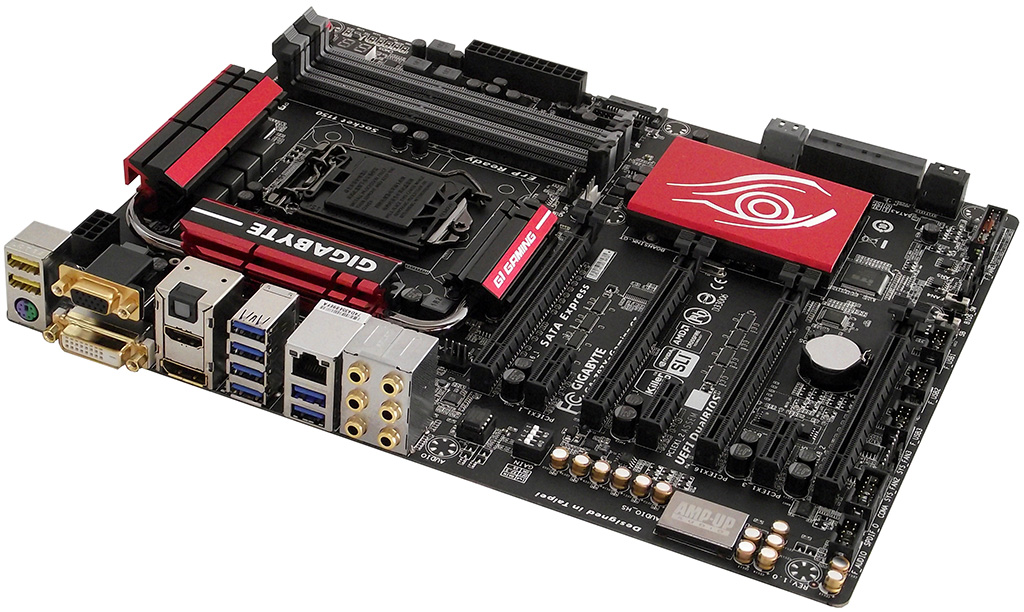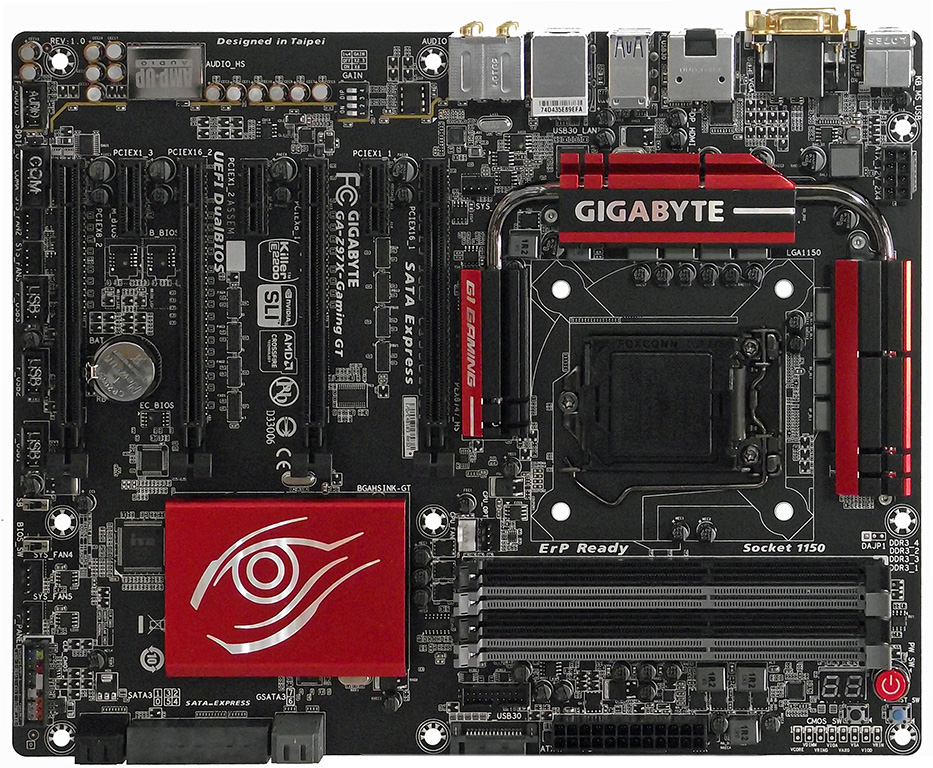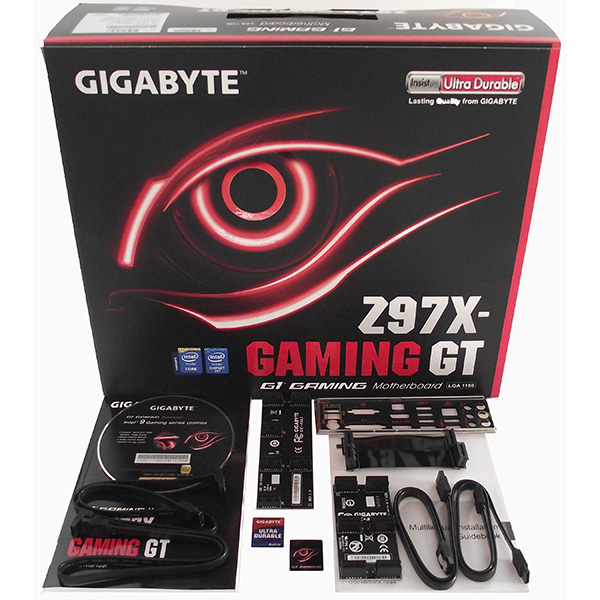Three Z97 Express Motherboards, $220 To $280, Reviewed
Gigabyte Z97X-Gaming GT Hardware
Gigabyte doesn’t play around with fake slots on its Z97X-Gaming GT, instead placing four PCIe x16 slots cable of at least PCIe 3.0 x8 mode and filling the spaces between with PCIe 2.0 connectivity. The I/O panel is similarly filled up with six USB 3.0 and two USB 2.0 ports. Gigabyte even classes that area up with gold-plated audio and video connections.
The word “Gaming” is strategically placed in its name, so Gigabyte’s cheapest four-way SLI-capable board also boasts a replaceable TI OPA2134 op-amp to help gamers push their high-impedance headphones. A row of DIP switches provides hardware-level custom gain control.
Spaced to place four double-slot cards in an eight-slot case, the Z97X Gaming can also put two triple-slot cards in a standard ATX seven-slot chassis, gaining access to one of the PCIe x1 slots in that configuration. Unlike ASRock's board, this one doesn’t shift a pair of cards down to x8 bandwidth whenever an Ultra M.2 drive is present, mostly because it doesn’t support Ultra M.2. All sixteen PCIe 3.0 lanes are permanently connected to graphics slots, with the PEX 8747 bridge repeating those sixteen lanes of data to two PCIe x16 cards simultaneously. As with Gigabyte’s competitor, smaller two-lane switches allow the second and fourth graphics slots to steal half the lanes from the first and third slots in three- or four-way CrossFire/SLI.
Gigabyte knows its automatic Dual BIOS can be either a blessing or a curse (depending on what problem activates the feature), so it allows owners of its premium products to switch that feature off. Another switch lets you choose between firmware ROMs in single-BIOS mode.
Moving to the front edge, we find a connector that looks large enough to hold up to six ports, but actually only hosts four. It’s SATA-Express, so the rest of the space is dedicated to a PCIe x1 lane. The two SATA connectors to the left of that connector interface with the chipset, while the two ports on the right use an added-in 88SE9172 controller from Marvell.
Gigabyte adds a USB 3.0 hub to one of the chipset’s lanes, sharing a single port’s bandwidth between four of the I/O panel ports, while simultaneously losing one of the chipset’s other USB 3.0 ports. The four remaining are divided between two I/O panel connectors and a front-panel header that’s conveniently located above the top graphics slot, along the Z97X-Gaming GT’s front edge.
Overclocking is tied to the gaming theme with a row of voltage detection points near the top corner of the X97X Gaming GT’s front edge. Most gamers won’t have easy access, but overclocking exhibitionists typically use open test beds. Those enthusiasts will also appreciate the nearby power, reset and CLR_CMOS buttons, along with the board's two-digit status code display.
Get Tom's Hardware's best news and in-depth reviews, straight to your inbox.
What could be wrong with a layout this nice? Perhaps some users will experience the “I can’t believe my cable is too short” realization when connecting front-panel audio jacks to the board’s bottom-rear-corner header, but those folks should point their fingers at case makers first. While we like that some motherboard designs move this header slightly forward, we can’t blame platform vendors for a chassis designer's poor decisions.
The Z97X-Gaming GT includes four SATA cables (two have a single 90° end), two-, three-, and four-way SLI bridges and a CrossFire bridge.
Current page: Gigabyte Z97X-Gaming GT Hardware
Prev Page ASRock Z97 Extreme9 Software And Firmware Next Page Gigabyte Z97X-Gaming GT Software And Firmware-
Nuckles_56 Damn, nice boards but really expensive. A pity about the i7 4790k not performing well, as I really wanted to see which board was best at OC'ingReply -
InvalidError Seems like somewhat of a shame to test boards with a PCIE switch using only a single GPU. How many enthusiasts who spend in the neighborhood of $300 on a motherboard would settle for a single-GPU setup?Reply
This needs a follow-up with x16x16 PEX vs x8x8 native vs x16x16 LGA2011 and, hopefully, x8x8x8x8 PEX vs x16x8x8x8 native on LGA2011. -
jtd871 On-board wifi is simply a waste of space and power (and probably available pcie bandwidth) - even for mITX mobos. Wireless specifications change too frequently to get locked in to whatever is on your mobo. USB dongles are easier to upgrade/replace and allow more flexibility with respect to antenna placement.Reply
If you really can afford 3 GPUs, you should really be starting with X99. For Z97, full-size ATX boards are kind of a waste due to the limit on available PCIe lanes, unless you want just 1 GPU and a bunch of other 1-2-lane expansion boards. I would have preferred seeing what you can get in a uATX (or possibly mITX) solution for the same budget in a package that's arguably a better fit to cater to the SLI/CF crowd and easier to fit in a case. -
envy14tpe Love to see things at their full potential, but can we include a i5-4690k for comparison? Many people don't need what the i7 offers and would love to see how the i5 overclocks and performs on these motherboards.Reply -
rolli59 Really when it comes down to that class of boards and money is no issue, the question is; is your color theme, red, yellow or blue?Reply -
SessouXFX Anodized Gold. :PReply
That one MSI board...I hope that price isn't accurate, that they're currently out of stock or something else is going on, as in, it's being shipped from S. Korea... -
fl-gators-fan Very nice to see the Gigabyte Gaming GT coming out ahead, as that's the board I'm using. I've had it for about 2 months with the I7-4790K and haven't even tried overclocking yet. The 4.0 GHz is plenty fast for all I do :)Reply -
Gurg So this indicates that for what it costs to try to dress a 4790k up, you will spend at least as much as a higher performing 5820k.Reply -
InvalidError Reply
While the motherboard and CPU may cost about the same, you also need to throw in an extra $100 for DDR4.14541735 said:So this indicates that for what it costs to try to dress a 4790k up, you will spend at least as much as a higher performing 5820k.



